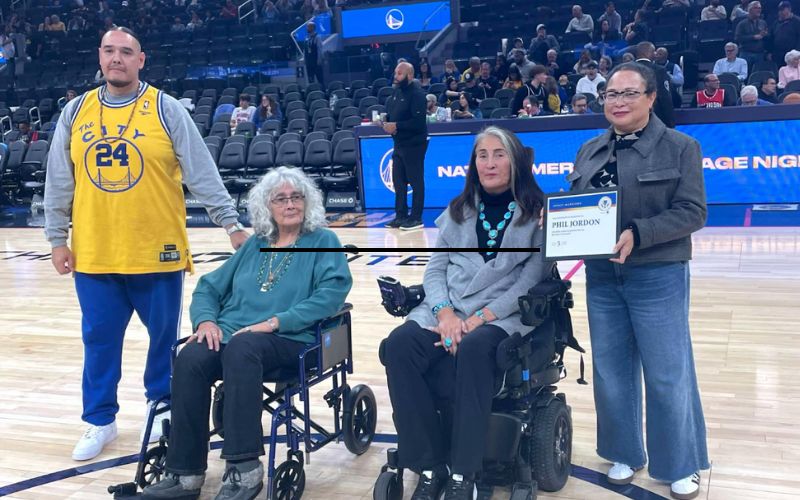
- Details
- By Native News Online Staff
At the Chase Center in San Francisco, history and heritage came together on January 5, 2025, as Phil “The Flash” Jordon, the first Native American player in NBA history, was honored with the Golden State Warrior Impact Award.
The Golden State Warrior Impact Award is presented to individuals who have made a significant contribution to their communities or have broken barriers in their respective fields.
The recognition, which took place during the Sacramento Kings vs. Golden State Warriors game, celebrated Jordon’s achievements in basketball while highlighting the cultural traditions of the Paskenta Band of Nomlaki Indians.
Phil Jordon, a descendant of the Nomlaki and Wailaki tribes, broke barriers when he entered the NBA in 1956. Over a seven-year career, he played for teams such as the Cincinnati Royals, Detroit Pistons, New York Knicks, and St. Louis Hawks.
Known for his agility and skill on the court, Jordon earned the nickname “The Flash.” His journey into the league paved the way for future Native athletes to see themselves represented at the highest levels of professional sports.
Jordon’s daughter Juliana and his sister Shirley accepted the award on his behalf, reflecting on his legacy and the inspiration he continues to provide for Native communities.
The evening also included a performance by the Nomlaki Weleaq Olkapna Dancers, who brought traditional music and dance to the court. Their performance offered a connection to Jordon’s roots and offered the audience a deeper understanding of the Paskenta Band of Nomlaki Indians traditions.
“We are deeply proud of Phil Jordon’s accomplishments in the NBA and the inspiration he continues to provide in Indian Country,” Tribal Chairman Brandin Paya said in a press release. “It is also an incredible honor to have the Golden State Warriors invite our dancers to share a piece of our culture through song and dance. This is truly a night to remember for the Nomlaki Tribe.”
Born in 1933, Jordon grew up with a love for sports that carried him to the professional level. Standing at 6’10”, Jordon quickly made a name for himself with his athleticism and versatility.
He played in 467 games over his NBA career, amassing 3,383 points and 2,107 rebounds. While his on-court achievements were impressive, his role as the first Native American player in the league made him a trailblazer for Indigenous representation in professional sports.
Jordon’s journey was not without challenges. Playing in an era when Native athletes were rarely seen in professional sports, he faced the pressures of performing at an elite level while navigating the stereotypes and biases of the time.
Yet he persisted, leaving behind a legacy that continues to inspire Native youth to dream big and pursue their goals.
More Stories Like This
Zuni Youth Enrichment Project Takes Top Emerging Artist Apprentices to Phoenix for Artistic Exploration and Cultural ImmersionFrom Dishwasher to Award-Winning Chef: Laguna Pueblo's Josh Aragon Serves Up Albuquerque's Best Green Chile Stew
Rob Reiner's Final Work as Producer Appears to Address MMIP Crisis
Vision Maker Media Honors MacDonald Siblings With 2025 Frank Blythe Award
First Tribally Owned Gallery in Tulsa Debuts ‘Mvskokvlke: Road of Strength’
Help us defend tribal sovereignty.
At Native News Online, our mission is rooted in telling the stories that strengthen sovereignty and uplift Indigenous voices — not just at year’s end, but every single day.
Because of your generosity last year, we were able to keep our reporters on the ground in tribal communities, at national gatherings and in the halls of Congress — covering the issues that matter most to Indian Country: sovereignty, culture, education, health and economic opportunity.
That support sustained us through a tough year in 2025. Now, as we look to the year ahead, we need your help right now to ensure warrior journalism remains strong — reporting that defends tribal sovereignty, amplifies Native truth, and holds power accountable.
 The stakes couldn't be higher. Your support keeps Native voices heard, Native stories told and Native sovereignty defended.
The stakes couldn't be higher. Your support keeps Native voices heard, Native stories told and Native sovereignty defended.
Stand with Warrior Journalism today.
Levi Rickert (Potawatomi), Editor & Publisher


